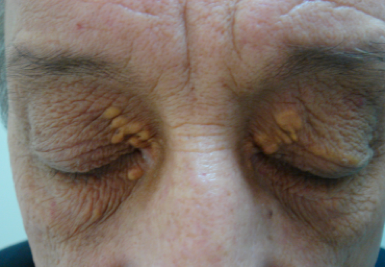Yellow growths on or near the eyelids are known as xanthelasma. They could be level or a little elevated. They develop as cholesterol (also known as lipid or fat) deposits accumulate beneath the skin. Xanthelasma are harmless in and of themselves, however they can be a symptom of heart disease.
Some people believe that xanthelasma is related to inheriting high amounts of blood fat and cholesterol from one’s parents. Up to 50% of people who have xanthelasma also have excessive cholesterol. The cholesterol levels of the other half are normal. however, some people believe that xanthelasma has additional causes, such as inflammation.
Xanthelasma can affect anyone. But if you smoke, are overweight, have high blood fat levels like cholesterol, have high blood pressure, or have diabetes, you are more likely to develop it. Moreover, women and people of Asian or Mediterranean ancestry are more likely to develop xanthelasma.
The skin around your eyes can notify a doctor whether you have xanthelasma. To determine the amount of lipids in your blood, they could prescribe a test. This may reveal whether your xanthelasma is being caused by a probable medical condition.
Xanthelasma do not disappear by themselves. They frequently increase in size or remain the same size. Despite the fact that they are typically safe, you could want to get rid of them for cosmetic reasons. Treatment for xanthelasma involves eliminating the deposit with laser surgery, cryotherapy (very cold or freezing surgery), conventional surgery to remove and mend the skin, electric needle surgery (extreme heat treatment), and chemical peels.
The majority of therapies are effective at removing xanthelasma. However, there could be adverse effects include scarring and a change in skin tone. Xanthelasma may also return back after surgery.
Taking steps to manage cholesterol with diet, exercise, and in some cases, cholesterol-lowering medication is imperative. This can enhance your general health and assist to stop the recurrence of xanthelasma. Some strategies for lowering cholesterol include the avoidance of eating foods high in saturated fats, such as butter, fried foods, and fatty meats. If you can, exercise every day. Even a 30-minute brisk walk is beneficial. Avoid smoking or, if you can, give up, and Do not drink as much.
Xanthelasma could be an indication that your blood vessels are accumulating cholesterol. This inhibits blood flow and may cause a heart attack or stroke. Visit your doctor for routine checks to reduce your risk of developing heart issues. They can assist you in maintaining heart health.
At The Eye Center- Dr. Mahnaz Naveed Shah & Associates our team of eight ophthalmology subspecialists/ eye specialists, eye surgeons who are considered amongst the very best eye specialists in Karachi and in Pakistan, have the diagnostic and treatment capabilities to treat from the simplest to the most complex patients. We work hard to provide our patients with the best possible medical and surgical eye care, in a state of the art purpose built eye care facility. We offer the entire array of medical, laser and surgical treatments to help provide patients the best possible care in the most efficient, safe and ethical manner.
If you need an appointment, please contact us at 03041119544 during our working hours or leave us a WhatsApp message at +923028291799 and someone will connect with you. Walk-in appointments are also available for emergencies. We can also be reached through our web portal on www.surgicaleyecenter.org


